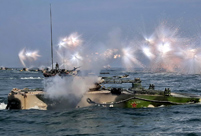 Amphibious armored vehicle unit conducts open sea drill
Amphibious armored vehicle unit conducts open sea drill
 Water relay in Henan
Water relay in Henan
 Ethnic culture feasts eyes of travelers
Ethnic culture feasts eyes of travelers
 80 security dogs assembled in Nanjing police dog training base
80 security dogs assembled in Nanjing police dog training base
 Graffiti artists paint on street walls in Xinjiang
Graffiti artists paint on street walls in Xinjiang
 Story of ceramic artist Zhang Lingyun
Story of ceramic artist Zhang Lingyun
 Magic summer night dream in Hongyuan
Magic summer night dream in Hongyuan
 Incredible creatures in headwaters drainage region of Lancang River
Incredible creatures in headwaters drainage region of Lancang River
 The future of rock n' roll seen in young rockers in China
The future of rock n' roll seen in young rockers in China
 Magnificent Yanziya Cliff
Magnificent Yanziya Cliff
The Japanese air self-defense force intruded into the East China Sea Air Defense Identification Zone on August 6.
Japan has failed to give response to the intrusion, a provocative act in serious violation of standard international practice, said Yin Zhuo, military expert and Major General of China.
A Japanese F-15 twice attempted to close with Chinese aircraft. The Chinese air force identified the intruder and took reasonable measures to deal with the threat and to ensure safety.
The establishment of East China Sea Air Defense Identification Zone was a preventative measure to safeguard China’s air order and safety. China’s air force undertook the necessary identification procedures on August 6, in a case where an aircraft from a foreign force entered the identification zone, said Shen Jinxiao, press spokesman of China's air force.
Asked whether Japan’s actions would cause conflict in the East China Sea, Yin Zhuo said: "China needs Japan’s response about the incursion of its aircraft into the East China Sea Air Defense Identification Zone. Although this area is international, it is China’s exclusive economic zone and Air Defense Identification Zone. Japan’s actions violate standard international practice, not international laws."
According to standard international practice, scouting aircraft should keep 150m from other planes, to avoid crashes. Fire control radar can be used for detecting, scanning, and warning, but must not be locked, and weapons cannot target. Firstly, Japan failed to give response to the intrusion into China’s Air Defense Identification Zone. Secondly, the Japanese plane twice came ‘unusually close’ to our scouting aircraft. These irregular actions were aggressive and provocative.
The article is edited and translated from《日军机侦察我防空识别区 非常规做法具挑衅意味》, source: People.cn, author: Huang Zijuan
 Beijing policewomen posters become a hit
Beijing policewomen posters become a hit Armored regiment trains on the sea
Armored regiment trains on the sea Children spend 'Father's Day' with dads at work
Children spend 'Father's Day' with dads at work 'Pan Da' appear in Shanghai World Financial Center
'Pan Da' appear in Shanghai World Financial Center Champions take selfies on podium
Champions take selfies on podium National Fitness Day celebrated around China
National Fitness Day celebrated around China Traditional culture colors summer vacation
Traditional culture colors summer vacation Young athletes fighting for their dreams
Young athletes fighting for their dreams 68 meters high thermometer in Shanxi, called ‘fighter’ of thermometers
68 meters high thermometer in Shanxi, called ‘fighter’ of thermometers The vanishing folk skills
The vanishing folk skills Intoxicating beauty of Dali, Yunnan province
Intoxicating beauty of Dali, Yunnan province Memorable moments of Ludian earthquake
Memorable moments of Ludian earthquake Bring world together to help elephant
Bring world together to help elephant 'Building Dreams'
'Building Dreams'  Labrang Monastery
Labrang MonasteryDay|Week|Month